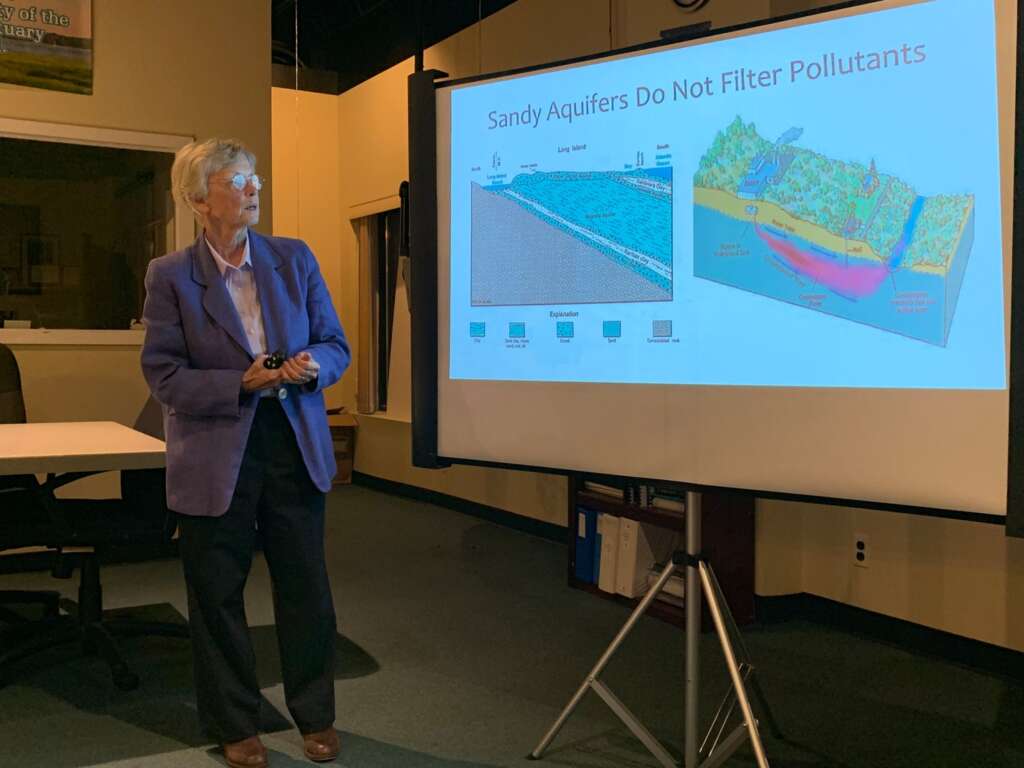Source:![]()
Experts: Long Island’s Drinking Water is Polluted
Mike Conn
Oct 03, 2019

Dr. Sarah Meyland, the director of the New York Institute of Technology’s Center for Water Resources Management, spoke to a group at Friends of the Bay in Oyster Bay on September 26. During her presentation, Meyland discussed the challenges surrounding the quality of Long Island’s drinking water, highlighting concerns over various contaminants present in the region’s water supply.
The water sourced from underground aquifers is often assumed to be naturally filtered as it passes through sand and soil. However, while certain particles such as dirt and bacteria may be removed, some chemicals and solvents may still be present. Chemicals such as perfluorinated compounds (PFAS) and 1,4 dioxane are examples of substances that may not be filtered out through natural processes.
Dioxane is a chemical compound commonly used as a stabilizer in various products like antifreeze, soaps, and cosmetics. Due to its molecular structure, it can be challenging to treat in water. While studies have shown potential health risks associated with exposure to this substance, including its possible effects on various organs, further research is ongoing to fully understand its impact on human health.
The state has established guidelines for acceptable levels of certain contaminants in drinking water, including dioxane. According to studies, some wells may exceed these levels, and a number of wells in the region may require treatment to address potential contaminants, including dioxane. It is important to monitor and address the presence of such substances to maintain water quality.
Addressing the presence of certain contaminants, such as dioxane, in water systems can be costly. While there have been allocations for treatment efforts, additional funding may be required to adequately address the contamination in affected areas.
Some conventional water treatment methods may not be effective at removing certain contaminants. In such cases, alternative treatment processes may be required to address specific contaminants in the water supply.
State officials have noted that meeting the demand for new water treatment technologies can be challenging due to the number of suppliers needing such solutions. Additionally, it is required that treatment systems undergo appropriate review and approval processes before they can be implemented.
A proposed bill is under review that could allow municipal water districts to take legal action against polluters. Such actions could potentially recover significant costs associated with contamination. Additionally, there is ongoing effort to address the presence of certain chemicals in household products.
“The key point is that a water system must meet applicable state and federal standards in order to deliver safe water,” he said.
Scientists estimate that there are numerous types of perfluorinated compounds, also known as “persistent chemicals” due to their slow breakdown in the environment. These compounds are commonly found in a variety of household products. If ingested, the human body may take a considerable amount of time to process and eliminate these substances. Some studies suggest that these compounds may be linked to various health concerns, including effects on the kidneys, liver, and other organs. Advanced treatment methods are often needed to address these chemicals in drinking water.
Meyland noted that regulatory agencies at both the state and federal levels have faced challenges in establishing sufficient protections. She also emphasized the importance of effective regional management of groundwater resources.
Meyland highlighted that the condition of Long Island’s drinking water remains a concern, with new contaminants continuing to be discovered and overall contamination persisting.
DuBois, a long-time resident of Oyster Bay Cove and a volunteer with Friends of the Bay, expressed increased concern after hearing Meyland’s presentation. “The more you learn, the more you realize the extent of the issue.”